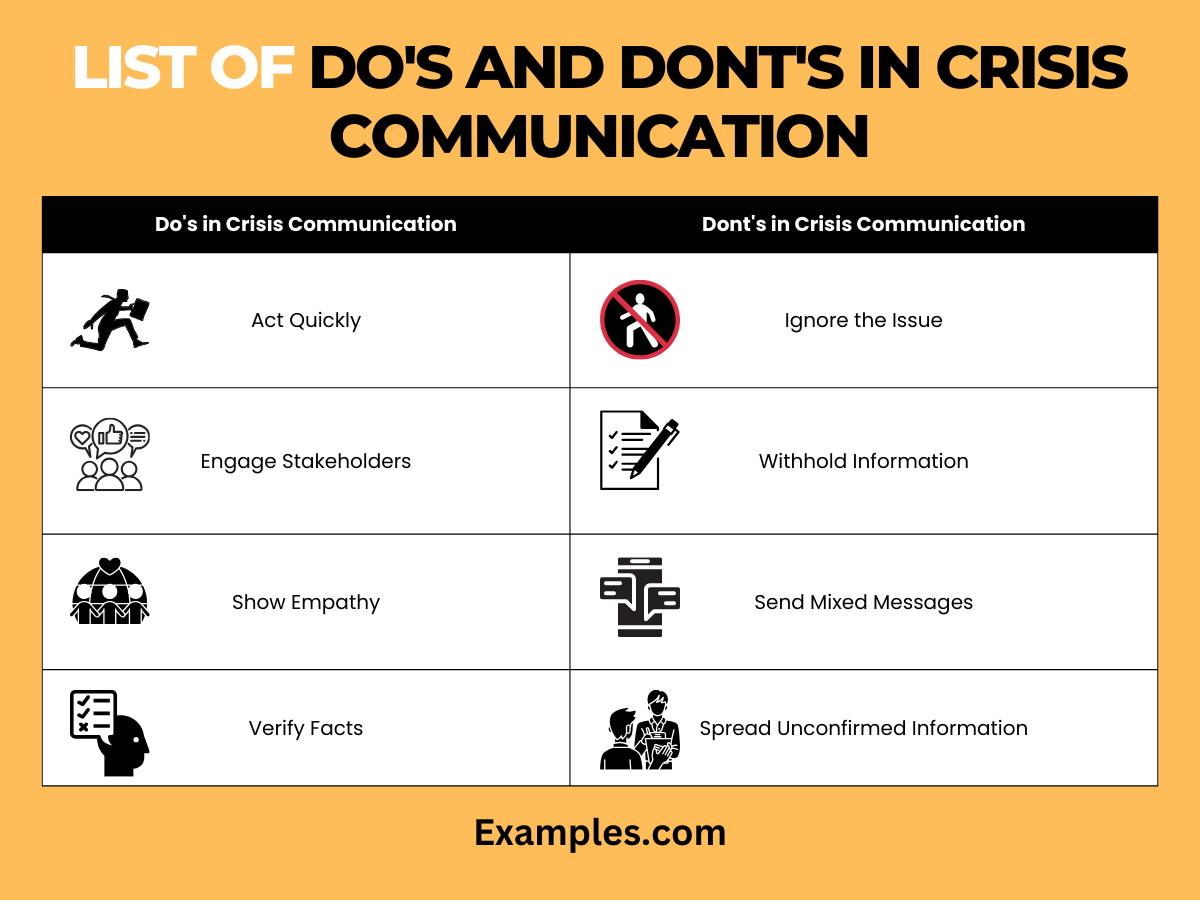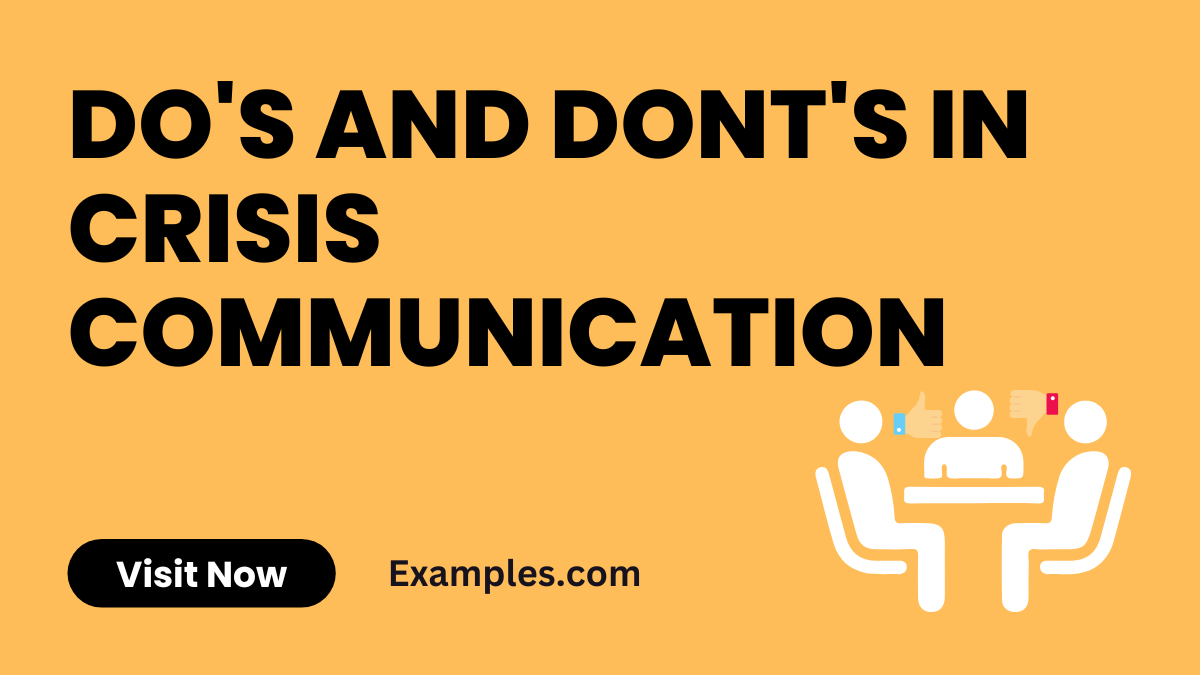Do’s and Dont’s in Crisis Communication – 9+ Examples, How to Avoid
Navigating the complex world of Crisis Communication requires a keen understanding of its do’s and don’ts. This section delves into the key strategies and common pitfalls in communicating during crises. From fostering rapid response to ensuring transparency, these guidelines are essential for anyone looking to manage crisis situations effectively. Learn how to craft messages that resonate and maintain credibility, while avoiding the common mistakes that can escalate a crisis.
List of Do’s and Dont’s in Crisis Communication

Do’s of Crisis Communication
1. Act Quickly
In Crisis Communication, acting quickly is crucial. Rapid response can prevent misinformation and panic, allowing you to shape the narrative effectively. Quick action demonstrates control and commitment to resolution, showing stakeholders that you are actively managing the situation. It’s about being ahead of the story, providing timely updates, and being the primary source of information, which is essential in maintaining trust and credibility during a crisis.
2. Be Transparent
Transparency is key in Crisis Communication. It involves openly sharing information about the crisis, being honest about its impacts, and not withholding significant details. Transparent communication builds trust with stakeholders and the public. It shows that your organization values integrity and is committed to resolving the issue. Being transparent also means admitting mistakes, if any, which can go a long way in maintaining credibility and respect.
3. Show Empathy
Showing empathy in crisis situations reflects understanding and concern for those affected. It’s about acknowledging the impact of the crisis on individuals and communities, and responding in a manner that demonstrates care and consideration. Empathy in communication humanizes your response, fosters goodwill, and helps in rebuilding trust. It’s not just about what you communicate, but also how you communicate, making sure that your tone and words reflect genuine concern.
4. Verify Facts
Factual accuracy is paramount in Crisis Communication. Providing verified and accurate information helps maintain credibility and trust. It’s important to double-check facts before dissemination to avoid the spread of misinformation, which can escalate the situation. Accurate information also provides a solid foundation for stakeholders to understand the situation and make informed decisions. It’s about ensuring the reliability and integrity of your communication.
5. Maintain Consistency
Consistency in messaging is vital in Crisis Communication. It involves ensuring that all information released is aligned and coherent across different channels and platforms. Consistent messaging helps in avoiding confusion and ensures that your audience receives a unified message about the crisis and your response. It reinforces clarity and helps in managing perceptions and expectations effectively.
6. Engage Stakeholders
Stakeholder engagement is a critical aspect of Crisis Communication. It involves identifying and communicating with all parties affected by the crisis. Engaging stakeholders means keeping them informed, addressing their concerns, and considering their feedback in your response. Effective engagement helps in building and maintaining trust, and can provide valuable insights for resolving the crisis more effectively.
7. Prepare in Advance
Preparation is a key element of effective Crisis Communication. Having a crisis communication plan in place ensures that you are not caught off guard. A well-prepared plan includes identified spokespersons, predefined communication channels, and templates for crisis messages. Advance preparation enables a quicker and more coordinated response, reducing the potential damage of the crisis.
8. Train Your Team
Training your team is essential in Crisis Communication. A well-trained team knows how to respond in a crisis, understands their roles, and can communicate effectively. Training should cover crisis response procedures, communication guidelines, and media handling. A trained team is better equipped to manage crises, ensuring a cohesive and effective response.
9. Monitor Social Media
In the digital age, monitoring social media is a critical component of Crisis Communication. Social media platforms are where news breaks and spreads rapidly. Monitoring these platforms helps in understanding public perception, identifying misinformation, and addressing concerns promptly. It allows for real-time engagement and provides a platform to respond quickly and effectively to the evolving situation.
10. Offer Apologies When Needed
Apologizing when necessary is a crucial aspect of Crisis Communication. A sincere apology can go a long way in repairing trust and beginning the process of resolution. It demonstrates accountability and responsibility for the situation. However, apologies should be genuine and accompanied by actions that show commitment to fixing the issue and preventing future occurrences.
Dont’s of Crisis Communication
1. Ignore the Issue
Ignoring a crisis can exacerbate the situation. In Crisis Communication, acknowledging the issue promptly is crucial. Ignoring it can lead to a loss of control over the narrative and damage trust. Stakeholders expect timely acknowledgement and action. Neglecting to address the crisis can result in rumors and misinformation filling the void, potentially causing greater harm to the organization’s reputation and stakeholder relationships.
2. Withhold Information
Withholding information during a crisis can severely damage trust and credibility. Transparency is a cornerstone of effective Crisis Communication. Concealing information, especially when it is likely to emerge later, can lead to accusations of deceit and undermine public confidence. It’s important to share information responsibly, ensuring stakeholders are aware of the situation and the steps being taken to address it.
3. Be Insensitive
Insensitivity in crisis situations can have lasting negative impacts on an organization’s reputation. In Crisis Communication, it’s important to consider the emotional and psychological effects of the crisis on stakeholders. Insensitive remarks or actions can be perceived as uncaring or dismissive, damaging relationships and trust. Communicating with empathy and understanding is crucial in maintaining respect and goodwill.
4. Spread Unconfirmed Information
Spreading unconfirmed information can lead to misinformation and panic. In Crisis Communication, ensuring the accuracy of the information before sharing is vital. Sharing unverified facts can escalate the crisis and diminish credibility. It’s important to cross-check all facts and rely on verified sources before making any public statements to maintain trust and authority.
5. Send Mixed Messages
Sending mixed messages can create confusion and uncertainty. Consistency in Crisis Communication is key to clear understanding. Inconsistent or contradictory messages can lead to misunderstandings and mistrust. It’s crucial to ensure that all communication, across all channels and from all spokespeople, is aligned and coherent to avoid confusion and misinformation.
6. Overlook Stakeholder Concerns
Overlooking stakeholder concerns can lead to a lack of engagement and trust. In Crisis Communication, addressing the needs and worries of stakeholders is essential. Ignoring their concerns can give the impression that the organization is out of touch or indifferent, which can damage relationships and trust. Engaging with and responding to stakeholder concerns demonstrates empathy and commitment to resolution.
7. Be Unprepared
Being unprepared for a crisis can result in chaotic and ineffective communication. In Crisis Communication, preparation is key. Lack of a crisis communication plan can lead to delayed responses, confusion, and errors. Having a plan, trained spokespersons, and clear procedures in place ensures a more effective and coordinated response during a crisis.
8. Forget to Train Staff
Forgetting to train staff can lead to inconsistent and incorrect messaging. In Crisis Communication, every team member should understand their role and how to communicate during a crisis. Untrained staff may inadvertently share incorrect information or respond inappropriately, potentially exacerbating the situation. Regular training ensures that everyone is prepared and aligned with the crisis communication strategy.
9. Neglect Online Discussions
Neglecting online discussions, especially on social media, can allow misinformation to spread unchecked. In the digital age of Crisis Communication, online platforms are critical for gauging public sentiment and responding to concerns. Ignoring these platforms can result in a narrative controlled by speculation and rumors, which can be detrimental to the organization’s image and efforts to manage the crisis.
10. Refuse to Apologize
Refusing to apologize when necessary can be perceived as arrogance or a lack of accountability. In Crisis Communication, a sincere apology can be a powerful tool in rebuilding trust. It demonstrates responsibility and empathy. Avoiding an apology can lead to public backlash and further damage the organization’s reputation and stakeholder relationships.
How to Avoid Mistakes in Crisis Communication
Effective Crisis Communication is critical in managing challenging situations with precision and care. Avoiding mistakes is key to maintaining trust and credibility. Here are five essential points to help avoid common errors:
Establish Clear Communication Channels
Ensure that there are well-defined communication channels for disseminating information during a crisis. This approach prevents the spread of misinformation and ensures that stakeholders receive accurate updates directly from the source. It’s about having a streamlined process where information flows efficiently to all concerned parties.
Develop a Comprehensive Crisis Communication Plan
A detailed crisis communication plan is your roadmap during turbulent times. This plan should include protocols for identifying and assessing a crisis, key messaging, stakeholder mapping, and a clear chain of command for decision-making. Regularly updating and rehearsing this plan ensures preparedness, enabling a swift and coordinated response that minimizes mistakes.
Train Spokespersons and Communication Teams
Well-trained spokespersons and communication teams are less likely to make errors in delivering critical messages. Regular training sessions should focus on crisis scenarios, message formulation, media handling, and soft skills like empathy and assertiveness. This training ensures that your team is not just prepared to handle a crisis but also adept at communicating effectively under pressure.
Monitor and Respond to Public Sentiment
Keeping a close eye on public sentiment, especially on social media, allows for real-time adjustments in your communication strategy. This monitoring helps in identifying misinformation or growing concerns that need addressing. Responding to these sentiments in a timely and appropriate manner can prevent the escalation of issues and ensure your message resonates with the audience.
Conduct Regular Post-Crisis Reviews
Analyzing your crisis communication performance after the fact is crucial. Regular post-crisis reviews help identify what worked well and what didn’t. This continuous learning approach allows you to refine your strategies, update your crisis communication plans, and improve overall readiness for future crises. It’s a critical step in evolving your crisis management capabilities.
Navigating Crisis Communication effectively demands a strategic blend of the do’s and don’ts outlined in this guide. Adhering to these practices ensures clear, empathetic, and responsible communication, crucial in maintaining trust and credibility. Remember, every crisis presents an opportunity to demonstrate competence and care, making these guidelines indispensable for any effective crisis communication strategy.



